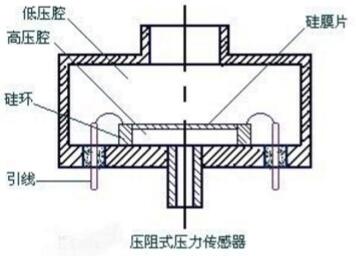push time:2023-06-26 Popularity: source:1
Pressure sensors are the most commonly used sensors in industrial practice and instrument control, and are widely used in various industrial automation environments, including water conservancy and hydropower, railway transportation, production automation, aerospace, military, petrochemical, oil wells, power, ships, machine tools, pipelines, and many other industries.
There are various types of mechanical sensors, such as resistance strain gauge pressure sensors, semiconductor strain gauge pressure sensors, piezoresistive pressure sensors, inductive pressure sensors, capacitive pressure sensors, resonant pressure sensors, and capacitive acceleration sensors. But the most widely used is the piezoresistive pressure sensor, which has extremely low price, high accuracy, and good linear characteristics. The following mainly introduces these types of sensors.
Principle of Piezoresistive Pressure Sensors
Piezoresistive pressure sensors are sensors made using the piezoresistive effect of monocrystalline silicon materials and integrated circuit technology. Piezoresistive sensors are commonly used for measuring and controlling pressure, tension, pressure difference, and other physical quantities that can be transformed into force changes, such as liquid level, acceleration, weight, strain, flow rate, and vacuum degree.
Piezoresistive effect
When a force acts on a silicon crystal, the lattice of the crystal undergoes deformation, causing the scattering of charge carriers from one energy valley to another, causing changes in the mobility of charge carriers, disturbing the average amount of charge carriers in both the longitudinal and transverse directions, and thus causing changes in the resistivity of silicon. This change varies with the orientation of the crystal, so the piezoresistive effect of silicon is related to the orientation of the crystal. The piezoresistive effect of silicon is different from that of metal strain gauges. The change in resistance with pressure in the former mainly depends on the change in resistivity, while the change in resistance in the latter mainly depends on the change in geometric size (strain). Moreover, the sensitivity of the former is 50-100 times higher than that of the latter.
Comparison between resistive pressure sensors and piezoresistive pressure sensors Transmission of resistive pressure sensors
A resistive sensor is a device that measures the strain of the input mechanical quantity; Epsilon; Transforming elements that convert into changes in resistance values. The input of the resistance converter is strain; Epsilon-& Amp; Delta; L/L, which is the relative change in length of a material, is a dimensionless relative value. Usually& Epsilon- 10-6 is a microstrain. The output of a resistance converter is the relative change in resistance value; Delta; There are two types of R/R0 resistance converters: metal resistance converters and semiconductor resistance converters. Based on the piezoresistive effect of semiconductor materials; Delta& Amp; Rho/& Amp; Rho-& Amp; Pi& Amp; Sigma; And& Sigma- E& Epsilon; Where& Sigma; Is the stress (F/S)& Amp; Pi; It is the piezoresistive coefficient and E is the elastic modulus, so the relative change in resistance is (& Delta; R/R)& Asymp& Amp; Pi; E& Epsilon;. To measure other physical quantities, such as pressure, force, etc., it is necessary to first attach a strain gauge to the corresponding elastic element. These physical quantities are converted into strain of the elastic element, and then the strain is converted into resistance output through the strain gauge.

Piezoresistive pressure sensor structure and transmission Piezoresistive pressure sensor adopts an integrated process to integrate the resistance strip onto a single crystal silicon film, making a silicon piezoresistive chip. The periphery of this chip is fixed and encapsulated in the shell, and electrode leads are led out. Piezoresistive pressure sensors, also known as solid-state pressure sensors, are different from adhesive strain gauges in that they require indirect sensing of external forces through elastic sensing elements, but rather direct sensing of the measured pressure through a silicon diaphragm. One side of the silicon diaphragm is a high-pressure chamber connected to the measured pressure, and the other side is a low-pressure chamber connected to the atmosphere. Silicon membranes are generally designed as circular shapes with fixed supports around them, with a diameter to thickness ratio of approximately 20-60. Four P impurity resistance bars are locally diffused on a circular silicon membrane (N-type) and connected to form a full bridge. Two of them are located in the compressive stress zone and the other two are in the tensile stress zone, symmetrical relative to the center of the membrane. Silicon cylindrical sensitive components are also diffused in a certain direction on a certain crystal plane of the silicon cylindrical surface to produce resistance strips. Two resistance strips subjected to tensile stress and the other two resistance strips subjected to compressive stress form a full bridge.

Advantages and disadvantages of piezoresistive pressure sensors
Advantages of piezoresistive pressure sensors:
1. High frequency response, with f0 up to 1.5M;
2. Small size and low power consumption;
3. High sensitivity and good accuracy, capable of measuring to an accuracy of 0.1%;
4. No moving parts (sensitive components and conversion components integrated).
Disadvantages of piezoresistive pressure sensors:
1. Poor temperature characteristics;
2. The process is complex.
Pressure sensor applications
Piezoresistive sensors are widely used in various fields such as aerospace, aviation, navigation, petrochemical, power machinery, biomedical engineering, meteorology, geology, seismic measurement, etc. Pressure is a key parameter in the aerospace and aviation industries, requiring high accuracy in the measurement of static and dynamic pressure, local pressure, and the entire pressure field. Piezoresistive sensors are ideal sensors for this purpose.
For example, it is used to measure the airflow pressure distribution of helicopter wings, test the dynamic distortion of engine inlet, pulsation pressure of blade cascades, and wing flutter. In the measurement of center pressure in aircraft jet engines, specially designed silicon pressure sensors are used, with operating temperatures reaching over 500 ℃. A silicon pressure sensor with an accuracy of up to 0.05% is used in the atmospheric data measurement system of Boeing aircraft. In scaled down wind tunnel model tests, piezoresistive sensors can be densely installed at the inlet of the wind tunnel and in the engine intake duct model. A single sensor has a diameter of only 2.36 millimeters, a natural frequency of up to 300 kHz, and both nonlinearity and hysteresis are within the full range; Plusmn; 0.22%.
In biomedicine, piezoresistive sensors are also ideal detection tools. We have developed an injection needle type piezoresistive pressure sensor with a diffusion silicon film thin to 10 microns and an outer diameter of only 0.5 millimeters, as well as a sensor capable of measuring pressure in cardiovascular, intracranial, urethral, uterine, and intraocular regions. Figure 3 is a structural diagram of a sensor used for measuring brain pressure. Piezoresistive sensors are also effectively used for measuring explosion pressure and shock waves, vacuum measurement, monitoring and controlling the performance of automotive engines, as well as for measuring weapons such as gun bore pressure and launching shock waves. In addition, piezoresistive sensors are widely used in oil well pressure measurement, directional measurement while drilling, and detection of underground sealed cable fault points, as well as flow and liquid level measurement. With the further development of microelectronics technology and computers, the application of piezoresistive sensors will also rapidly develop.
Sales hotline:
Miss Chen: 18520271262
Miss Xie: 18688494254
Mr. Huang: 18688492451
Working hours:
Monday to Saturday9:0018:00
